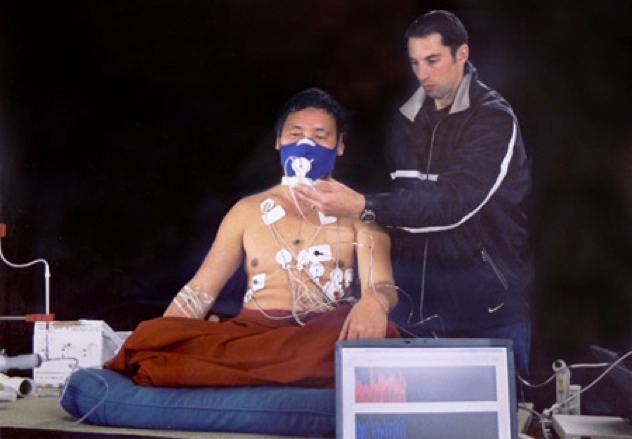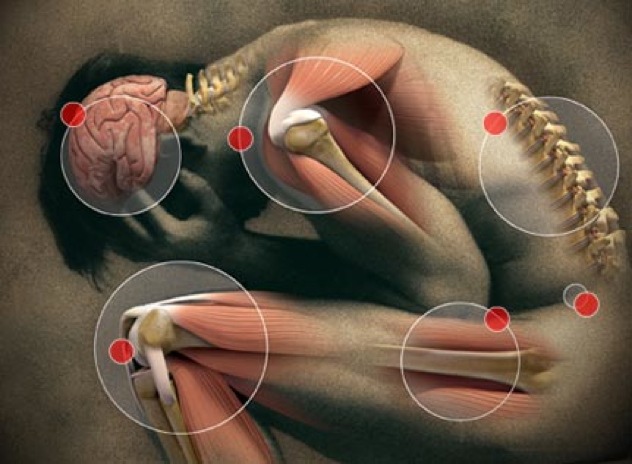 Animals
Animals  Animals
Animals  Weird Stuff
Weird Stuff 10 Weird Things That Warp Your Sense of Time
 Miscellaneous
Miscellaneous Ten More Extremely Unexpected U.S. State “Firsts”
 Humans
Humans 10 Ideas That Scare People to Death
 Music
Music The Cursed Decade: 10 Classic Rock Stars Who Had Low Periods in the 1980s
 Health
Health 10 Crazy Ways Sleep Deprivation Can Affect You
 History
History 10 Enthralling Facts about the Field of Cloth of Gold
 Pop Culture
Pop Culture The Ten Greatest Engineers in Science Fiction History
 Humans
Humans Ten Journalists Who Got Caught Faking the News
 Travel
Travel 10 Best Hiking Trails in America with Breathtaking Views
 Animals
Animals Ten Animals That Produce and Store Toxins in Unlikely Places
 Weird Stuff
Weird Stuff 10 Weird Things That Warp Your Sense of Time
 Miscellaneous
Miscellaneous Ten More Extremely Unexpected U.S. State “Firsts”
Who's Behind Listverse?

Jamie Frater
Head Editor
Jamie founded Listverse due to an insatiable desire to share fascinating, obscure, and bizarre facts. He has been a guest speaker on numerous national radio and television stations and is a five time published author.
More About Us Humans
Humans 10 Ideas That Scare People to Death
 Music
Music The Cursed Decade: 10 Classic Rock Stars Who Had Low Periods in the 1980s
 Health
Health 10 Crazy Ways Sleep Deprivation Can Affect You
 History
History 10 Enthralling Facts about the Field of Cloth of Gold
 Pop Culture
Pop Culture The Ten Greatest Engineers in Science Fiction History
 Humans
Humans Ten Journalists Who Got Caught Faking the News
 Travel
Travel 10 Best Hiking Trails in America with Breathtaking Views
10 Amazing Examples of Mind Over Matter
While we often think of our bodies and minds as two distinct entities, it turns out they are much more entwined than we might assume. Researchers are continually finding evidence that the brain has a distinct power to manipulate the body’s physiology. As these 10 examples show, the mind/body connection can work in our favor or detriment, depending on our knowledge of a situation and our ability to control our thoughts.

Judging by their ability to meditate for hours on end, abstain from food for days, and their vows of silence, most of us would agree that Tibetan Monks have better control over their minds and bodies than the average person. Still, what’s particularly amazing is some of them can control physiological processes, such as blood pressure and body temperature – feats many medical doctors find astounding.
In one of the most notable exhibits of their skills, a group of Tibetan monks allowed physicians to monitor the monk’s bodily changes as they engaged in a meditative yoga technique known as g Tum-mo. During the process, the monks were cloaked in wet, cold sheets (49 f / 9.4 c) and placed in a 40 f (4.5 c) room. In such conditions, the average person would likely experience uncontrollable shivering and would shortly suffer hypothermia. However, through deep concentration, the monks were able to generate body heat, and within minutes the researchers noticed steam rising from the sheets covering the monks. Within an hour, the sheets were completely dry.
Although the display was fascinating to the doctors, for the monks, it was an ordinary occurrence. In fact, new monks use g Tum-mo as a way of proving their meditative strength and hold contests to see who can dry the most sheets in one night.
The Buddhists say the heat they generate is a byproduct of meditation since it takes energy to reach a state of alternate reality – a place unaffected by our everyday world.
 Multiple personality disorder, or dissociative identity disorder, is a mental condition that’s interesting on many levels. Perhaps most intriguing of all is how some sufferers not only exhibit personality and behavior changes as they switch between their different identities, but some also have measurable physiological variations between each persona. For instance, one of a patient’s personalities may need eyeglasses, and another won’t. Or, one identity might be diabetic, and another will have perfect health. In such cases, it isn’t simply a matter of the patients thinking they need eyeglasses or insulin; their bodies actually go through legitimate alterations, such as differences in intraocular pressure or blood sugar levels.
Multiple personality disorder, or dissociative identity disorder, is a mental condition that’s interesting on many levels. Perhaps most intriguing of all is how some sufferers not only exhibit personality and behavior changes as they switch between their different identities, but some also have measurable physiological variations between each persona. For instance, one of a patient’s personalities may need eyeglasses, and another won’t. Or, one identity might be diabetic, and another will have perfect health. In such cases, it isn’t simply a matter of the patients thinking they need eyeglasses or insulin; their bodies actually go through legitimate alterations, such as differences in intraocular pressure or blood sugar levels.
In one case, published by the American Psychiatric Press, a doctor noted how medications prescribed to a dissociative identity disorder patient had different effects depending on what “personality” took the drug. For example, when a tranquilizer was given to the person’s childish persona, it made the individual sleepy and relaxed. However, when the adult personality was administered the same drug, it made him anxious and confused. Similar results were found with other patients and with a variety of different medications. Doctors even noticed visibly apparent traits, like lazy eye, would come and go depending on which personality was present.
This phenomenon is especially fascinating since no one, including the patients, claims mysticism is at work. On the contrary, it is a genuine example of the mind altering the body.

A placebo is an inert substance or belief which produces real biological effects in humans. It’s so widely accepted as a fact that a placebo variable is included in most medical tests as a way of proving if, say, a drug works on its own merits or because people “think” it works.
There are tons of experiments showing proof of the placebo. Still, one of the most amusing to watch is a test done by a group of Princeton students who decided to throw a non-alcoholic keg party for their unsuspecting classmates. The experimenters secretly filled a keg with O’Douls (which contains about 0.4% alcohol while regular beer has around 5% alcohol) and then watched as their peers acted silly, slurred words, slept on the ground, and generally acted drunk. Although it’s nearly impossible to get intoxicated on O’Douls, these college students had such a strong belief they were drinking standard beer that it affected their behavior.
Curiously, researchers have discovered the placebo effect is somehow getting stronger. Some drugs that have been on the market for years, such as Prozac, are now proving less effective than placebos. Naturally, this is a major issue for big pharmaceutical companies, which has left many scrambling to conduct neurological studies to develop new ways to safeguard their industry from ordinary sugar pills. Incidentally, Big Pharma is currently more profitable than Big Oil, so there’s quite a bit at stake.

While placebos are generally associated with positive outcomes, like curing an illness or getting drunk on O’Douls and having fun (if you consider that positive), the nocebo effect produces negative results, such as a cancer patient vomiting before chemotherapy starts or someone breaking out in a rash because they thought they touched poison ivy, even though it was merely an ordinary plant.
One of the most talked-about examples of the nocebo phenomenon was an incident published in “New Scientist.” According to the account, late one night, an Alabama man, referred to as Vance, went to a cemetery and met up with a witch doctor who told Vance that he would die soon. Believing the witch doctor’s prediction, Vance soon fell ill and was emaciated and close to death within a matter of weeks. Vance was taken to the hospital, but the medical doctors could find nothing wrong with him. Finally, Vance’s wife told the physician, Dr. Doherty, about the encounter with the witch doctor, which gave the creative physician an idea. The next day, Dr. Doherty told the couple he had tracked down the witch doctor and physically threatened him until the medicine man finally admitted he had put a lizard inside Vance that was eating him from the inside. Of course, the Doctor’s story was completely fabricated, yet he made a big show of injecting the patient with a mysterious substance and snuck in a genuine, green lizard that he pretended to extract from Vance. The next day, Vance awoke alert, hungry, and it didn’t take long before he fully recovered.
Apparently, that story was corroborated by four other medical professionals and is often cited when explaining why Voo Doo sometimes works (i.e., not because of magic, but because of the nocebo effect).

Many stories are floating around out there about people who experienced an injury in their dreams and then found real, physical evidence of the wound on their bodies once they awoke. For instance, some people have claimed to have been caught in a fire in their dreams and then woke up to find burn marks on their skin. Other common stories involve people being attacked during their dreams and then waking up to find scratch marks somewhere on their bodies. However, most of these stories are found in chat rooms or message boards, so it’s hard to corroborate if they are true.
But, there is one well-documented case, reported by famed psychiatrist Ian Stevenson, about an Indian man named Durga Jatav who, during a battle with typhoid fever, had an extremely vivid dream about being held captive in another realm. To keep him from escaping, his dream captors cut his legs off at the knee. Unfortunately, his legs were already severed by the time the captors realized they had the wrong man and didn’t need to keep Jatav after all. When Jatav asked how he could leave with no legs, they offered him several pairs of legs, he picked out his own pair, and then they were miraculously reattached.
While Jatav was having the dream, his body became very cold, and at one point, his family thought he was dead, yet he revived a few days later. Once he was awake, his sister and neighbor noticed deep fissures around his knees that weren’t there previously. X-ray photographs showed no abnormality below the surface of the skin, which led Jatav and his family to believe the marks came from his dream experience. Dr. Stevenson met Jatav some 30 years later (1979) and took pictures of the still visible scars. Although Stevenson did not witness the event, he apparently believed the story, which was confirmed by all involved, and he even included the account and photographs in his book “Reincarnation and Biology: A Contribution to the Etiology of Birthmarks and Birth Defects.”
Obviously, there’s no scientific proof to this intriguing account, but it’s not too far-fetched considering what we already know about the power of the brain over the body.

Like the Tibetan monks, Indian Yogis seem to have an unusual talent for manipulating their physiological processes while in deep meditation. After hearing stories of yogis spending 28 days underground and surviving, in 1936, a French cardiologist named Therese Brosse traveled to India to see if the yogis truly did have such talents. In her experiments, the yogis reportedly slowed their heart down so slow that it was only detectable via an EKG machine.
In the 1950s, Brosse’s study was expanded by another group of researchers who traveled through India with an eight-channel electroencephalograph and various other instruments, which they used to monitor the yogis’ brain activity, respiration, skin temperature, blood-volume changes, and skin conductance. Two of their test subjects were placed in air-tight sealed boxes on two separate occasions and were monitored for 8 to 10 hours. During that time, the Yogis showed biological characteristics similar to sleep. They were able to slow down their heart rate and respiration to low enough levels that oxygen and carbon dioxide quantities inside the box remained virtually in the same proportions as found in the air at sea level. Thus, it was shown that by slowing down their bodily processes and not panicking (as most would do), the Yogis could survive a live burial for far longer than the average person, possibly even weeks longer.

Many athletes claim visualization helps them perform better when they “play” the game in their minds before ever stepping foot on the field or court. While we might assume doing so is just a mental exercise that enables them to better focus on the game, there might be more concrete changes happening inside the body.
For example, Air Force Colonel George Hall was locked in a small, dark North Vietnamese prison for seven years. While most would lose their minds in such circumstances, Hall went to his happy place, so to speak, by mentally playing golf every day of his imprisonment. His visualizations were extremely in-depth and included everything from hitting the ball off the tee, raking the sand traps, feeling the wind, and of course, tapping the ball into the hole.
Regardless of being weak and 100 pounds lighter than before his capture, one of the first things Hall wanted to do after his release was play a legitimate round of golf. He was invited to the Greater New Orleans Open, where he astoundingly shot a 76. When a member of the press suggested his performance was a case of beginners luck, Hall replied, “Luck, I never 3-putted a green in the last five years!”
So, despite his physical deterioration and not stepping on a course in over seven years, his body had developed muscle memory based simply on his imaginings.
 Jack Schwarz, a Dutch Jewish writer, also lived in horrific conditions while forced into a Nazi concentration camp during World War II. Like so many others, he was beaten, starved, and tortured beyond what most of us can comprehend. To cope with his situation, he began the practice of meditation and prayer, which he developed to the point where he could block out the pain of his torment and subsequently withstand his situation.
Jack Schwarz, a Dutch Jewish writer, also lived in horrific conditions while forced into a Nazi concentration camp during World War II. Like so many others, he was beaten, starved, and tortured beyond what most of us can comprehend. To cope with his situation, he began the practice of meditation and prayer, which he developed to the point where he could block out the pain of his torment and subsequently withstand his situation.
After his release, Schwarz continued his mind over matter practice and occasionally demonstrated his skills by putting a long sailmaker’s needle through his arm without injury. He also displayed his ability to regulate his body’s blood flow by causing the puncture hole in his arm to bleed or stop bleeding at will. Schwarz was studied by researchers at the Menninger Foundation who found that he could indeed control many of his bodily processes with only his mind. Furthermore, through an electroencephalograph, they determined his brain had different electrical activity than most other test subjects. Schwarz could also see people’s auras, which allowed him to gauge their physical, emotional, spiritual, and mental conditions.

Undoubtedly it’s difficult to keep a positive attitude when you’re facing a life-threatening disease. Still, based on a variety of medical studies, doing so may mean the difference between living and dying.
For example, in 1989, Dr. David Spiegel of Stanford University conducted a study on 86 women with late-stage breast cancer. Half of those women received standard medical care, while the other half were given weekly support sessions in addition to the standard medical care. During the sessions, the women shared their feelings, talked with other patients, and generally had a positive outlet to cope with their illness. At the end of the study, the women in the support group lived twice as long as those not in the group. In 1999, a similar study found that cancer patients who have feelings of helplessness and hopelessness have a lower chance of survival.
In recent years, David Seidler, writer of “The King’s Speech,” claimed to have eliminated his cancer through meditation and imagination. After battling bladder cancer for years and only two weeks away from surgery, Seidler decided to see if he could get rid of the cancer through his imagination. He admittedly thought the idea was a little “woo-woo,” but by that point, he figured he had nothing to lose. So, he spent the two weeks leading up to his surgery envisioning a clean, cream-colored, healthy bladder. When Seidler went in for his pre-surgery biopsy, the doctor was stunned to find a distinct lack of cancer – he even sent the biopsy to four different labs for testing. While Seidler believes his visualization was behind the cancer’s disappearance, his doctor labeled it a “spontaneous remission.”

It seems counterintuitive that increasing numbers of people are claiming to put a greater effort into exercising and eating a nutritious diet, yet there are more obese people in the world than ever before. Some researchers think positivity is a missing variable in the weight-loss equation, and a lack of it is what’s keeping people chubby.
To prove the point that the mind has a major impact on the body, Harvard psychologist Ellen Langer conducted an experiment on a group of predominantly overweight hotel maids who, judging by their daily activity levels, should have been thin. Despite essentially exercising all day long through their work, Langer discovered through a survey that 67% of the maids felt they didn’t do any exercise. Langer predicted the maids’ perceptions were hampering their weight loss, so she took half the maids aside and, in addition to taking their physical measurements, explained that through their cleaning work, they were exceeding the surgeon general’s definition of an active lifestyle. The other half of the maids were given no information.
A month later, Langer’s team returned to the hotel and reevaluated the maids. They found an overall decrease in systolic blood pressure, weight, and waist-to-hip ratio in the educated group. The other group had no significant physical changes. While some suspect the mere discussion of exercise somehow altered the women’s behavior, Langer said there was no indication that any of the maids modified their routines. She feels the results were due simply to a change in mindset.
Content and copy writer by day and list writer by night, S.Grant enjoys exploring the bizarre, unusual, and topics that hide in plain sight. Contact S.Grant here.








